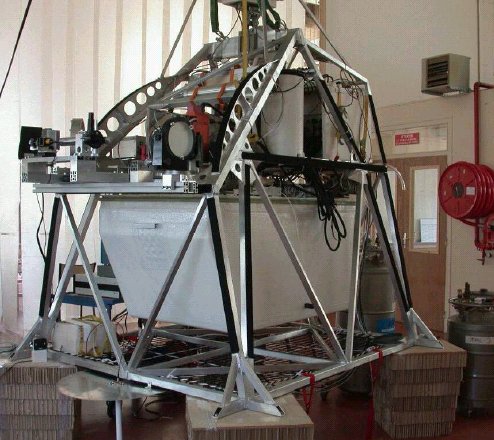Purpose of the flight and payload description
It is an advanced Fourier Transform Infra Red (FTIR) spectrometer specially tailored to the operation on a stratospheric balloon gondola. It allows precise limb emission sounding of chemical constituents related to the stratospheric ozone problem and the greenhouse effect. This method is appropriate to obtain vertical profiles of ozone and a considerable number of key radicals (NO, NO2), reservoir species (HNO3, N2O5, ClONO2, and HO2NO2) as well as source gases (CH4, N2O, H2O, CFC-11, CFC-12, CFC-22, CCl4, CF4, C2H6, and SF6) simultaneously, with an altitude resolution of 2 to 3 km.
The MIPAS-B experiment was also thought as precursor for a space version of MIPAS actually installed onboard ENVISAT.
The instrument is divided in five operational segments:
(1) the gondola,
(2) the line-of-sight (LOS) stabilization and reference system,
(3) the cryogenic spectrometer,
(4) the on-board electronics, and
(5) the ground control equipment
The gondola is a frame construction, developed by the Geneva Observatory, combining high stability and safety with relatively low weight and easy servicing.
The LOS system is based on a miniaturized inertial navigation system with embedded GPS (Global Positioning System) that provides the attitude and heading reference of the instrument frame needed for the control loop to maintain the LOS within 300 m at the tangent point. A CCD star camera takes images of stars in the direction of the LOS that are used as absolute reference.
The spectrometer consists of a three-mirror off-axis telescope, a double-pendulum interferometer, and a four channel liquid-He cooled infrared detector system. The heart of the instrument is the double pendulum interferometer, a modification of the classical Michelson set-up. The four-channel detector system allows the simultaneous coverage of the most important absorption bands of ozone-relevant molecules between 5.2 and 13.3 µm.
The analogue data is sampled on-board, mixed with the information of the other channels and the housekeeping data, and sent to ground via telemetry at a data rate of 250 kbit/s. An uplink connection of 1200 bit/s ensures full commandability of the instrument during flight.
On ground, the raw data is split up again and stored immediately in a data base. At the same time, housekeeping data and interferograms can be viewed and processed to allow on-line evaluation of measured data and of instrumental health.
Details of the balloon flight
Balloon launched on: 9/24/2002 at 18:43 utc
Launch site: Centre de Lancement de Ballons CLBA, Aire Sur L'Adour, Landes, France
Balloon launched by: Centre National d'Etudes Spatiales (CNES)
Balloon manufacturer/size/composition: Zero Pressure Balloon
End of flight (L for landing time, W for last contact, otherwise termination time): 9/24/2004 at 23:47
Campaign: ENVISAT
The balloon was launched by dynamic method assisted by auxiliar balloon at 18:43 utc on September 24, 2002.
After a nominal ascent phase the float was reached at a maximum ceiling altitude of 39188 m at 21:47 UT i.e. 20 min before the Envisat overpass. Due to a surprisingly northern component of the wind direction at this altitude, which would have brought the gondola over the Pyrenean mountains, the valve had to be opened for some time to bring the balloon down by about 1600 m where the wind blew from west.
The balloon maintained that flight level until 23:47 utc when the cutdown command was transmited.
This was the flight # 11 of MIPAS-B2 and the first to be performed with a downsized estructural version of the gondola for weightless purposes. During the flight all the system worked in a nominal manner and both the Fournier spectrometer and the LOS pointing system operated perfectly. During the two hours of leveled flight were obtained a couple of complete limb sequences.
External references
- MIPAS website Institut für Meteorologie und Klimaforschung - Universität Karlsruhe
- ENVISAT Validation with MIPAS-B Envisat Validation Workshop 9-13 December 2002 ESRIN, Frascati, Italy
- MIPAS Ozone Validation by Stratospheric Balloon and Aircraft Measurements 2nd Workshop on the Atmospheric Chemistry Validation of ENVISAT, 2004
- MIPAS-B Observations for the Validation of Target Parameters of ENVISAT Chemistry Instruments 2nd Workshop on the Atmospheric Chemistry Validation of ENVISAT, 2004
- Overview of SCIAMACHY validation: 2002-2004 Atmos. Chem. Phys., 6, 127-148, 2006
- The Validation of the Envisat Chemistry Instruments by Use of Stratospheric Balloons and Aircraft ENVISAT Validation Workshop (ESA SP-531). 9-13 December, Frascati, Italy
- Validation of MIPAS CH4 Profiles by Stratospheric Balloon, Aircraft, Satellite and Ground Based Measurements 2nd Workshop on the Atmospheric Chemistry Validation of ENVISAT, 2004
- Validation of MIPAS N2O Profiles by Stratospheric Balloon, Aircraft and Ground Based Measurements 2nd Workshop on the Atmospheric Chemistry Validation of ENVISAT, 2004
- Validation of MIPAS Temperature Profiles by Stratospheric Balloon and Aircraft Measurements 2nd Workshop on the Atmospheric Chemistry Validation of ENVISAT, 2004
- Validation of MIPAS-ENVISAT Version 4.61 HNO3 Operational Data by Stratospheric Balloon, Aircraft and Ground-Based Measurements 2nd Workshop on the Atmospheric Chemistry Validation of ENVISAT, 2004
- Validation of MIPAS-ENVISAT Version 4.61 Operational Data: NO2 2nd. Workshop on the Atmospheric Chemistry Validation of ENVISAT, 2004
170If you consider this website interesting or useful, you can help me to keep it up and running with a small donation to cover the operational costs. Just the equivalent of the price of a cup of coffee helps a lot.


